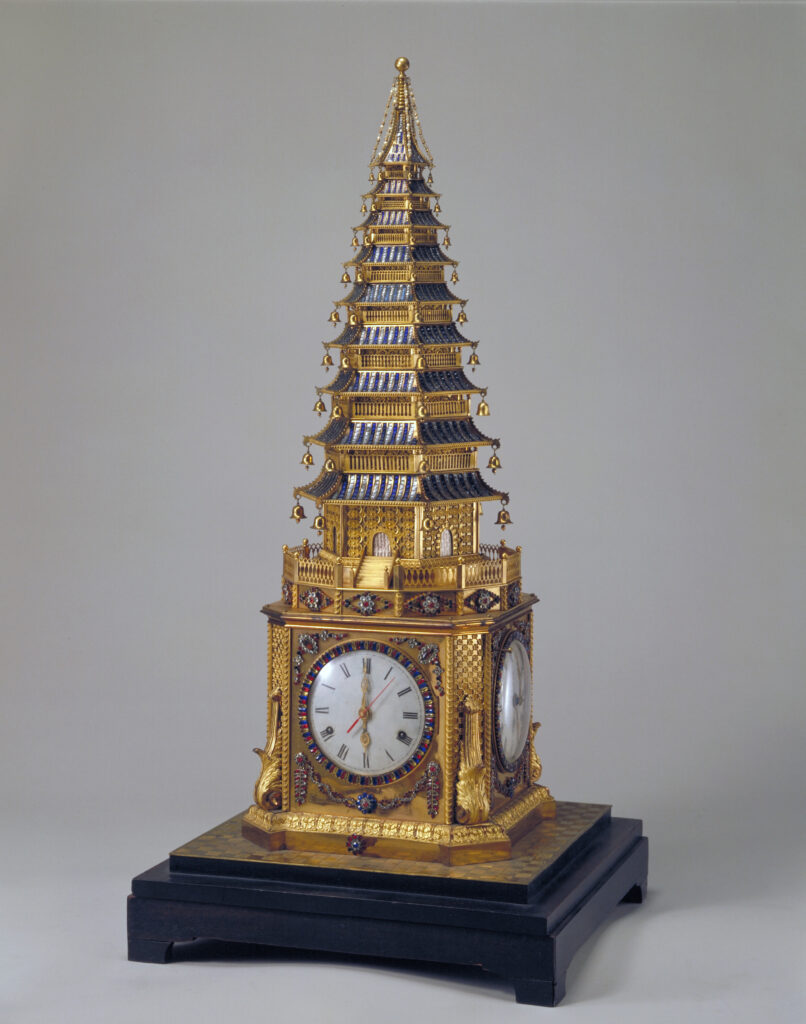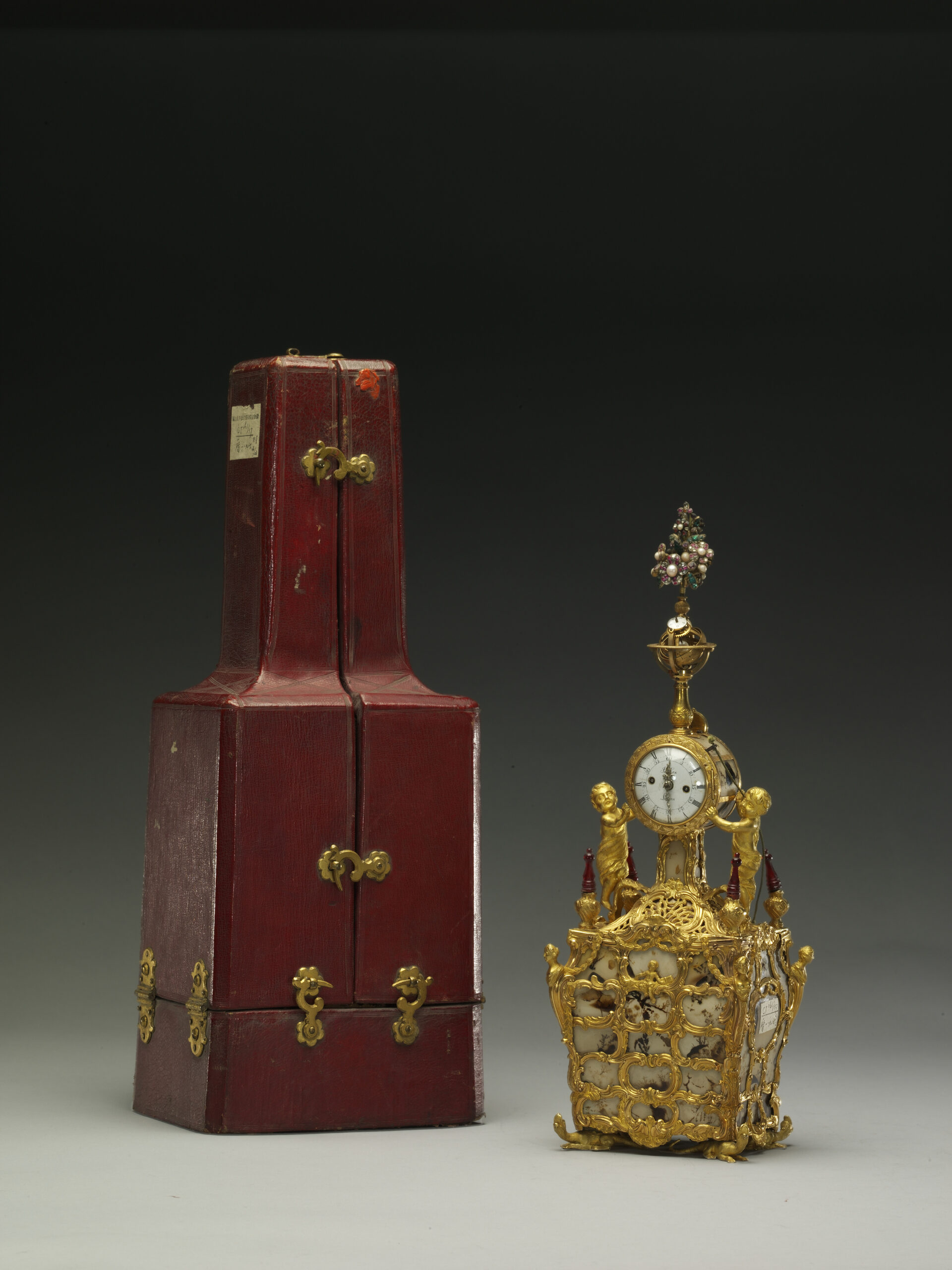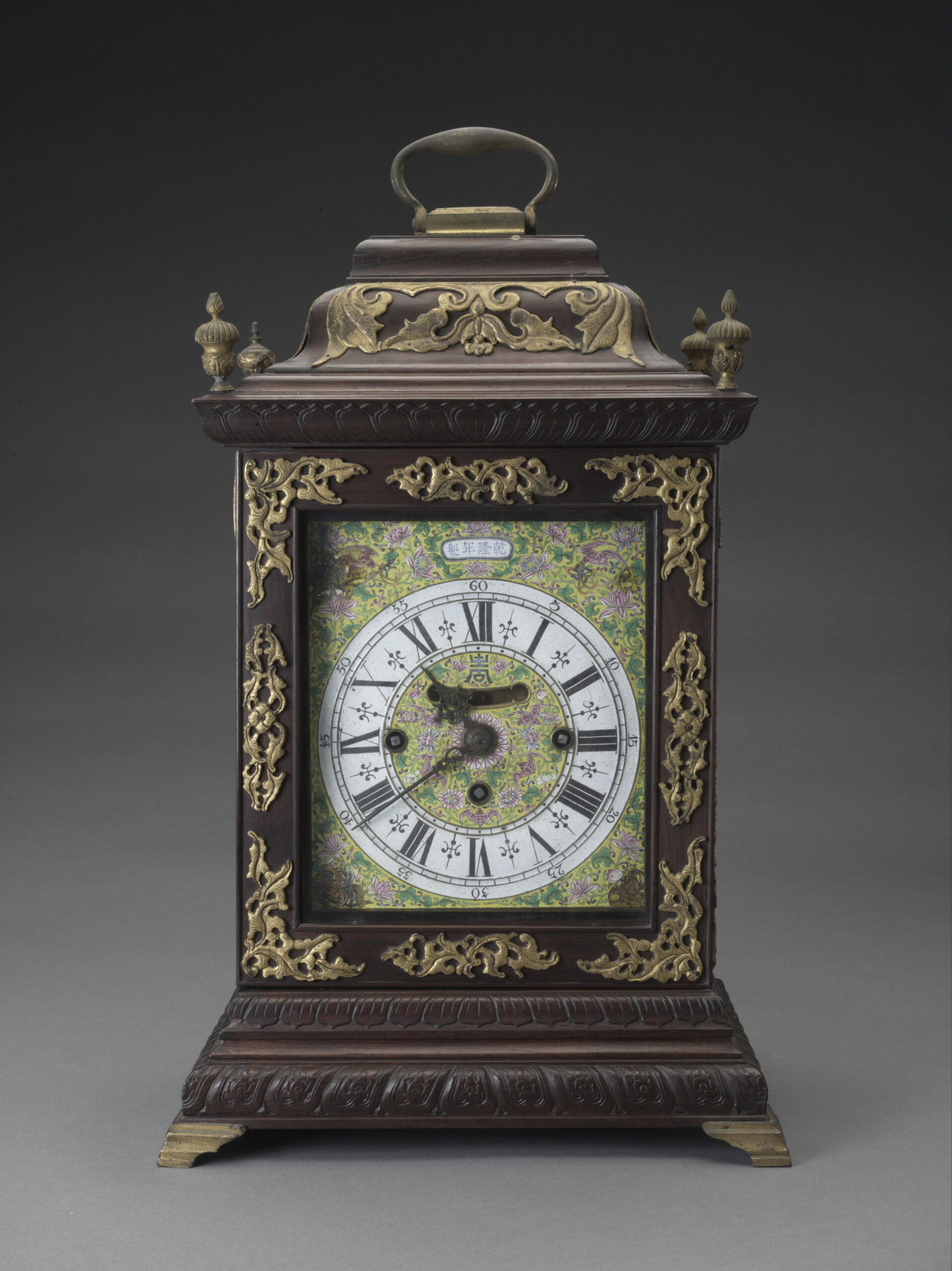Every time I visit the exhibition Zimingzhong 凝时聚珍: Clockwork Treasures from China’s Forbidden City I notice or learn something new. Often these changes in my perspective come about through conversation with others. Take the first of the clockwork automata, also known as zimingzhong, in the exhibition – the Moving Pagoda Zimingzhong whose tiers elevate while the clock plays the Chinese song The Molihua (translated as The Jasmine Flower) in a nearby video. The clock was made in Britain to appeal to the Chinese market and would have been shipped to Guangzhou (then Canton) with a shape and sound expressing British perceptions of Chinese culture.

What I never considered until I chatted with Coco Shi – PhD student at the UCL Institute of Education – was how British clockmakers in the 1700s had come to know the song The Jasmine Flower in the first place. The song became a global phenomena after being used in Puccini’s last opera Turandot in 1926 and then again through being played in every medal ceremony in the 2008 Beijing Olympics.
When we played the song at the London Chinese Community Centre in Chinatown, as part of the Communicating Time and Culture research project, it was met with members humming and singing along.
The song’s popularisation in Europe is associated with the geographer John Barrow. He would have first heard the song when he travelled to China as part of the Macartney mission of 1793, Britain’s first envoy to China. The mission, among other aims, sought to establish a permanent embassy in Beijing rather than having trade funnelled through Guangzhou over 1000 miles away. Famously, the Qianglong Emperor, rejected this request in a letter to George III stating:
‘Our Celestial Empire possesses all things in prolific abundance and lacks no product within its own borders. There was therefore no need to import the manufactures of outside barbarians in exchange for our own produce.’
Clocks however were a product that bucked this trend with the Qianlong Emperor, like his grandfather the Kangxi Emperor before him, amassing a vast collection of both European and Chinese clocks.
In addition to displaying these stunning timepieces in the UK for the first time, the exhibition reveals the motivation behind the Chinese emperor’s collection of zimingzhong. Far from being simply intellectual curiosities the clocks were closely connected to the emperors’ role as the divine mediators between Heaven and Earth.
As Wenjie Su, a researcher at the Courtauld and Princeton University, told me on a visit to the exhibition, ‘throughout imperial China, rulers paid immense attention to timekeeping and the study of heavenly patterns because this knowledge demonstrated they had the virtue to rule, or, their legitimate reception of the Mandate of Heaven. Discrepancies in calendars or the failure to predict and prepare for unusual celestial events would thus destabilize the political foundation of a dynasty. Novel instruments and ideas, such as those introduced by the Jesuits, were open-mindedly embraced by the emperor because in the Chinese intellectual tradition, the heavens were not immutable but always changed.’ At the exhibition, one clock bearing a tiny armillary sphere—a model demonstrating planetary motions—thus exemplified the deeper motivations of accurate timekeeping.
As Wenjie told me, ‘at the Qing court, the technology of clockmaking was also organically integrated with traditional religious iconographies. For example, when viewing the Pavilion Clock with The Eight Immortals from the side, the glass-panelled case would reveal to us how the age-old belief in Daoist immortals was now animated by spring-driven mechanical configurations.’
This issue of how the energy of the clocks is generated has been one of the key questions asked to me by members of the Chinese Centre in Soho. We’ve done several events with the London Chinese Community Centre and the scale model of the Song Dynasty water-powered clock invented by the Chinese polymath Su Song always attracts attention.
While water clocks have existed in China since the Qin Dynasty, Song was the first to use a water wheel to power the spring escapement mechanism. An increasing awareness of Su Song’s achievements in the 1950s in Europe fundamentally changed perspectives of escapement technology being a European invention.

One of the other aspects of the clocks that resonates with members of the London Chinese Community Centre are the array of visual puns used to echo Chinese characters. Lingzhi mushrooms and peaches featured on the Crane Clock represent longevity. Another clock which contains the rotating characters 大吉 (da ji), meaning ‘very lucky’, is shaped like a gourd renowned for containing many seeds and thus indicating fertility.
What looks at first like a stately European carriage clock contains ornate golden metalwork like the leathery wings of a bat: when you peer closely around the clock there are several small pink bats on the clock face. The Chinese word for bat 蝙蝠 biǎnfú, sounds like 福 fú, the Chinese character for good fortune.
As Beverley Lin, Director of the London Chinese Community Centre, told me, ‘Clocks do not always have positive connotations in China. In Cantonese the words to ‘gift a clock sounds’ like ‘paying one’s respects at a funeral’. Yet despite this, many Chinese clockmakers who rose in Guangzhou and the Forbidden City embraced the clock and incorporated a symbolism that connected clocks to positive attributes in Chinese cosmology.’
One of the most intriguing symbols on the clocks was pointed out to me by Ian, a member of the Chinese Community Centre’s youth group. He noticed several pineapples that adorned the pinnacles of the clocks. Today in China, the pineapple means that luck is coming your way.
Pineapples are indigenous to South America and when these clocks were being made in the 1700s they would have been an exotic addition and an expensive luxury at both the European and Chinese dinner table. As Ian told me, Europeans would even rent out pineapples to stand as the centrepiece of the dinner table.
With only two weeks to go before the clocks return to the Palace Museum in Beijing, I am intrigued what else might be discovered from the conversations I have with visitors the exhibition about the Zimingzhong, and urge you to visit if you have not yet done so. You can book a ticket here, and are invited to pay what you can (with a minimum ticket cost of £1.00 per person).
If you have an interpretation of the symbolism and meaning of the clocks, then do get at touch at research.publichistory@sciencemuseum.ac.uk.


